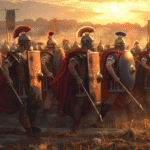Table of Contents
Who Was Alfred the Great? Life, Legacy, and Impact
Alfred the Great (849-899 CE) stands as the only English monarch ever granted the epithet “the Great”—a distinction earned through military genius, intellectual achievement, and visionary leadership that transformed Wessex from a beleaguered kingdom into the foundation of unified England. During his 28-year reign (871-899), Alfred defeated the Viking Great Heathen Army, revolutionized military organization, promoted literacy and education, codified law, and fundamentally reshaped Anglo-Saxon society.
If you’re studying medieval English history, the Viking Age, or state formation, understanding Alfred is essential. His reign represents a pivotal transformation—from the fragmented Anglo-Saxon heptarchy toward eventual English unity, from oral to written culture, from reactive defense to strategic military organization, and from tribal kingship to sophisticated governance.
This comprehensive study guide examines Alfred the Great through multiple analytical frameworks—biographical context, military strategy, administrative innovations, cultural achievements, and historical legacy—providing the foundation to critically engage with one of medieval history’s most consequential rulers.
Key Takeaways
- Alfred is the only English monarch called “the Great,” reflecting exceptional achievement in military, administrative, intellectual, and cultural spheres
- His victory at Edington (878 CE) saved Wessex from Viking conquest, leading to the Treaty of Wedmore that created the Danelaw and preserved Anglo-Saxon England
- Alfred’s burh system—fortified towns throughout Wessex—revolutionized medieval defense and created the foundation for English urban development
- He personally translated Latin works into Old English and established a court school, promoting literacy and preserving knowledge for future generations
- Alfred’s law code synthesized earlier Anglo-Saxon traditions with biblical principles, influencing English common law development for centuries
Understanding Alfred: Sources and Historical Context
Before examining Alfred’s biography and achievements, establishing what sources inform our knowledge is crucial.
Primary Sources
Asser’s Life of King Alfred (893 CE):
Author and context:
- Asser: Welsh monk from St. David’s
- Joined Alfred’s court ~885
- Wrote biography during Alfred’s lifetime
- Personal knowledge of king (claimed)
Content and reliability:
- Detailed biographical information
- Alfred’s childhood and education
- Viking wars and struggles
- Intellectual interests and achievements
- Reliability: High for events, hagiographic bias
Strengths:
- Contemporary account
- Inside perspective
- Rich biographical detail
- Cultural context
Weaknesses:
- Panegyric (praise) intent
- Possible exaggerations
- Some anachronisms
- Latin literacy bias
The Anglo-Saxon Chronicle:
Nature and compilation:
- Annalistic history of Anglo-Saxon England
- Multiple manuscript versions
- Compiled under Alfred’s patronage (~890s)
- Continued for centuries after
Alfred-era content:
- Year-by-year events
- Viking invasions documented
- Battles and treaties
- Political developments
- Reliability: High for events, West Saxon bias
Value:
- Contemporary documentation
- Political perspective
- Military details
- Chronological framework
Limitations:
- Pro-Wessex bias
- Limited detail on some events
- Propagandistic elements
- Gaps and inconsistencies
Alfred’s own writings:
Translations:
- Gregory’s Pastoral Care
- Boethius’s Consolation of Philosophy
- Augustine’s Soliloquies
- First fifty Psalms
- Parts of Bede’s Ecclesiastical History
Prefaces and additions:
- Alfred’s original commentary
- Philosophical reflections
- Personal observations
- Educational objectives
Value:
- Direct insight into Alfred’s thought
- Intellectual interests revealed
- Political philosophy
- Cultural values
- Reliability: High for Alfred’s views
Legal documents:
Alfred’s Law Code (Doom Book):
- Compilation ~890s
- Synthesized earlier codes
- Biblical integration
- New provisions
Charters and grants:
- Land transactions
- Administrative documents
- Royal authority expressions
- Dating and witnesses
Historical Context: The Viking Crisis
The Anglo-Saxon world Alfred inherited:
Political fragmentation:
- Seven kingdoms (Heptarchy):
- Northumbria, Mercia, East Anglia, Essex, Kent, Sussex, Wessex
- Mercia dominant 8th century
- Wessex rising early 9th century
- Constant inter-kingdom competition
Viking transformation (793-871):
- 793: Lindisfarne raid (Viking Age begins)
- 830s-850s: Increasing raid frequency
- 865: Great Heathen Army arrives
- 866-870: Conquest of Northumbria, East Anglia, Mercia
- 871: Alfred becomes king of threatened Wessex
When Alfred took throne:
- Three kingdoms destroyed
- Wessex under attack
- No clear allies
- Survival uncertain
- Cultural crisis deepening

Life and Reign of Alfred the Great
Alfred’s personal journey shaped his approach to kingship and crisis management.
Early Life and Lineage (849-871)
Birth and family:
Date and place:
- Born: 849 CE
- Location: Wantage, Berkshire
- Family: House of Wessex
- Father: King Æthelwulf (r. 839-858)
Royal lineage:
- Grandfather: Egbert (unified Wessex)
- Traced descent to Cerdic (legendary Wessex founder)
- Through Cerdic to Germanic god Woden (claimed)
- Royal pedigree legitimizing rule
Siblings:
- Æthelbald (king 858-860)
- Æthelberht (king 860-865)
- Æthelred (king 865-871)
- Alfred (king 871-899)
- Sister Æthelswith (married King Burgred of Mercia)
Succession pattern:
- Not primogeniture (eldest son)
- Brother-to-brother succession
- Practical during crisis (mature leaders needed)
- Alfred fifth son, unexpected king
Childhood and education:
Rome pilgrimage (853):
- Age 4, accompanied by retinue
- Met Pope Leo IV
- Possibly confirmed/blessed
- Cultural exposure (Italian manuscripts, learning)
- Later significance: Rome represented learning/civilization
Second Rome visit (855-856):
- With father King Æthelwulf
- Year-long stay
- More extensive exposure
- Æthelwulf married Judith of Francia (stepmother)
- Continental connections established
Education challenges:
Asser’s account:
- Claim: Alfred couldn’t read until age 12
- Mother’s book prize motivating learning
- Late literacy unusual for prince
- Possible illness interfering (chronic condition mentioned)
Alternative interpretation:
- Latin literacy delayed (vernacular earlier?)
- Hagiographic exaggeration (triumph over adversity)
- Educational practices different than assumed
- Political rather than intellectual education early
Intellectual development:
- Strong memory (Asser emphasizes)
- Oral learning traditions
- Listening to poems and histories
- Vernacular culture immersion
- Latin learning eventually
Military training:
- Weapons and horsemanship
- Battle tactics and leadership
- Viking warfare observation
- Command experience before kingship
Health issues:
Chronic illness:
- Asser mentions recurring painful affliction
- Modern speculation: Crohn’s disease, hemorrhoids, others
- Significantly affected Alfred
- Endured despite condition
- Possibly shaped character (endurance, determination)
Rise to the Throne (868-871)
Pre-kingship military experience:
Secondary command:
- Fighting under brother Æthelred
- Battle of Ashdown (871): Led division, achieved victory
- Multiple engagements with Vikings
- Demonstrated military capability
- Earned warrior reputation
Political position:
- Secundarius (secondary, heir)
- Not guaranteed succession
- Needed to prove worthiness
- Brother’s sons potential competitors
- Crisis favoring experienced warrior
Succession context (871):
Æthelred’s death:
- Died April 871
- Midst of Viking campaign
- Multiple battles that year
- Wessex under extreme pressure
- Immediate leadership needed
Alfred’s accession:
- Age: ~22 years old
- Experience: Several years of warfare
- Challenge: Ongoing Viking invasion
- Support: Witan’s backing crucial
- Legitimacy: Royal blood + proven capability
The Witan:
Composition:
- Ealdormen (regional nobles)
- Bishops and abbots
- King’s thegns (warriors)
- Advisers and officials
Functions:
- Electing/confirming kings
- Advising on policy
- Judging important cases
- Witnessing charters
- Collective wisdom
Alfred’s relationship:
- Worked through Witan
- Consensus building
- Not absolute monarchy
- Collaborative governance
- Legitimacy through consultation
Major Events During His Reign (871-899)
Initial crisis (871-878):
Early battles (871):
- Multiple engagements
- Mixed results
- Viking peace treaty (871)
- Money payment (Danegeld)
- Temporary respite
Gathering storm (871-877):
- Viking campaigns elsewhere (Mercia)
- Wessex relative peace
- Alfred strengthening defenses
- Preparing for inevitable return
Crisis and near-defeat (January 878):
Chippenham surprise:
- Twelfth Night (January 6, 878)
- Viking attack on royal court
- Guthrum’s forces seized Chippenham
- Alfred barely escaped
- West Saxon governance collapsed
Athelney refuge:
- Somerset marshes
- Guerrilla warfare
- Small loyal band
- Low point of reign
- Legend: Alfred and the cakes (probably apocryphal)
Context:
- Wessex seemingly lost
- Vikings controlling most kingdom
- Darkest hour
- Survival uncertain
Turning point: Battle of Edington (May 878):
Preparation:
- Alfred’s rallying call from Athelney
- Forces from Somerset, Wiltshire, Hampshire
- Meeting point: Egbert’s Stone
- Army assembly and morale restoration
Battle:
- Location: Edington (Ethandun), Wiltshire
- Opponent: Guthrum’s Viking army
- Result: Decisive West Saxon victory
- Viking flight to Chippenham
Siege of Chippenham:
- Two-week Viking resistance
- Eventually surrendered
- Negotiations began
Treaty of Wedmore (878):
Terms:
- Guthrum’s baptism (Alfred godfather)
- Christian name: Æthelstan
- Viking withdrawal from Wessex
- Boundary established
- Creation of Danelaw: Viking-controlled territory
Significance:
- Saved Wessex from conquest
- Established lasting division of England
- Recognized Viking territorial control
- Peace allowing reconstruction
- Alfred’s greatest military achievement
Consolidation and reform (878-892):
Military reforms:
- Burh system development (fortified towns)
- Navy construction
- Army reorganization (rotation system)
- Defensive infrastructure
Administrative reforms:
- Legal code compilation
- Governance improvements
- Taxation and resources
- Royal authority strengthening
Cultural initiatives:
- Educational programs
- Translation projects
- Literacy promotion
- Manuscript production
Renewed Viking threat (892-896):
New invasion:
- Large Viking force from continent
- Led by Hastein
- Wessex defenses tested
- Mobile Viking armies
Alfred’s response:
- Burh system proved effective
- Mobile royal army pursued Vikings
- Coordinated defense
- Vikings unable to establish permanent base
Results:
- Vikings eventually left (896)
- Wessex system vindicated
- Defensive strategy successful
- Alfred’s military vision proven
Final years (896-899):
Continued development:
- Educational expansion
- Translation work
- Legal refinement
- Consolidation of reforms
Death:
- October 26, 899
- Age: ~50 years
- Cause: Unknown (possibly chronic illness complications)
- Succeeded by son Edward the Elder
Alfred the Great’s Achievements and Legacy
Alfred’s multifaceted achievements across military, administrative, intellectual, and cultural domains earned him unique historical recognition.
Military Leadership and Innovation
Strategic vision:
Understanding the Viking threat:
- Mobile, seaborne forces
- Hit-and-run tactics
- Exploiting Anglo-Saxon weaknesses
- Seasonal campaigns
- Difficult to pin down
Alfred’s innovative response:
- Fixed defenses (burhs)
- Mobile field army
- Naval capability
- Coordinated system
- Strategic depth
The Burh System:
Concept:
- Network of fortified towns
- Strategic locations throughout Wessex
- Every settlement within 20 miles of burh
- Defensive refuge for population
- Economic and administrative centers
Implementation:
Burghal Hidage document:
- List of burhs and maintenance requirements
- Based on hide system (land measurement)
- Assessed each burh’s wall length
- Calculated manpower needs
- Systematic organization
Notable burhs:
- Winchester (capital)
- Southampton (port)
- Oxford (river crossing)
- Wareham (strategic location)
- 30+ total burhs
Construction:
- Earthwork ramparts and wooden palisades
- Some stone (Roman walls reused)
- Ditches and gates
- Internal street planning
- Garrison accommodations
Function:
- Population refuge during raids
- Trade and market centers
- Administrative headquarters
- Legal and judicial centers
- Urban development catalyst
Military effectiveness:
- 892-896 Viking invasions failed to establish bases
- Network prevented Viking control
- Population protection assured
- Economic activity maintained
Army reorganization:
The Select Fyrd:
- Professional standing force
- Rotational service (half on duty, half at home)
- Ensured constant readiness
- Trained warriors
- Better equipment
Thegnly obligation:
- Land held in exchange for military service
- Equipment requirements standardized
- Training expectations
- Hierarchical command
Mobility:
- Rapid response to Viking movements
- Multiple forces could be fielded
- Pursuit capability
- Strategic flexibility
Naval development:
Ship construction:
- Larger ships than Viking vessels
- 60+ oars (twice Viking standard)
- Higher freeboard
- Faster and more stable
- First English navy
Naval tactics:
- Intercepting Viking fleets
- Coastal defense
- River control
- Blockading Viking forces
Success:
- 896 naval battle victory
- Several Viking fleets captured/destroyed
- Maritime control contested
- Foundation for later naval power
Battle of Edington: Tactical analysis:
Pre-battle:
- Intelligence and scouting
- Force concentration
- Morale restoration
- Supply arrangements
Battle conduct:
- Shield wall formation
- All-day fighting
- Maintaining discipline
- Pursuit of broken enemy
Post-battle:
- Siege of Chippenham
- Negotiation from strength
- Favorable treaty
- Permanent settlement
Educational Reform and Promotion of Literacy
Alfred’s educational philosophy:
Diagnosis of crisis:
- Learning declined
- Latin literacy nearly extinct
- Monasteries destroyed by Vikings
- Knowledge being lost
- Cultural identity threatened
Personal commitment:
- Despite late literacy, became scholar
- Learned Latin as adult
- Personal translation work
- Leading by example
Educational program:
Court school establishment:
- Children of nobles educated
- Future administrators trained
- Vernacular and Latin instruction
- Scholarly community created
Scholar recruitment:
- Asser (Wales): Biographer and teacher
- Grimbald (Francia): Scholar and priest
- John the Saxon (Old Saxony): Scholar
- Plegmund (Mercia): Later Archbishop of Canterbury
- Wærferth (Worcester): Bishop and translator
Translation project:
Rationale:
- Make essential knowledge accessible
- Preserve learning during crisis
- Educate nobility and clergy
- Strengthen Christian culture
- Create vernacular intellectual tradition
Major translations (with Alfred’s involvement):
Gregory’s Pastoral Care:
- Guide for bishops
- Clerical education
- Practical wisdom
- Distributed to all bishops
Boethius’s Consolation of Philosophy:
- Classical philosophy
- Providence and free will
- Comfort in adversity
- Alfred added personal reflections
Augustine’s Soliloquies:
- Christian meditation
- Soul and immortality
- Philosophical dialogue
- Alfred’s additions substantial
Bede’s Ecclesiastical History:
- English Christian history
- National identity
- Scholarly history
- Cultural foundation
First fifty Psalms:
- Scripture translation
- Prayer and worship
- Personal devotion
- Incomplete at death
Orosius’s History Against the Pagans:
- World history
- Christian perspective
- Alfred added geographical sections
- Expanded knowledge
Alfred’s prefaces:
Pastoral Care preface:
- Most famous
- Laments educational decline
- Outlines revival program
- Calls for vernacular literacy
- Vision statement
Translation philosophy:
- Sense-for-sense (not word-for-word)
- Clarity over literalness
- Additions explaining concepts
- Making accessible
- Intelligent adaptation
Impact on English language and literature:
Old English prose development:
- Literary language established
- Vernacular prestigious
- Foundation for English prose tradition
- Translation techniques influential
Literacy expansion:
- Beyond clergy to nobles
- Vernacular literacy valued
- Educational infrastructure
- Cultural preservation
Manuscript production:
- Scriptoria revived
- Copying and distribution
- Preservation of texts
- Cultural continuity
Religious and Legal Contributions
Religious patronage and reform:
Monastic restoration:
- Vikings had destroyed many monasteries
- Alfred refounded and supported monasteries
- Athelney Abbey (founded by Alfred)
- Shaftesbury Abbey (daughter Æthelgifu first abbess)
- Infrastructure for learning and piety
Church-state cooperation:
- Close work with bishops
- Religious legitimacy for kingship
- Moral authority
- Unified Christian culture
Personal piety:
- Regular prayer
- Scriptural study
- Religious devotion genuine
- Model Christian king
Alfred’s Law Code (Doom Book):
Compilation process:
- ~890s composition
- Drew from earlier codes:
- Æthelberht of Kent (c. 600)
- Ine of Wessex (c. 694)
- Offa of Mercia (8th century)
- Biblical law integration
- New provisions added
Structure:
Biblical introduction:
- Ten Commandments
- Mosaic law excerpts
- Christian framework
- Divine authority claimed
Main code:
- Criminal law
- Property law
- Personal injury
- Social order
- Procedural rules
Key principles:
Proportionality:
- Punishment fit crime
- Wergild system (compensation for injury/death)
- Graded by social status
- Alternatives to blood feud
Royal authority:
- King’s peace extended
- Royal justice
- Order and stability
- Centralized power
Christian morality:
- Biblical influence
- Ethical standards
- Protection of vulnerable
- Just society vision
Notable provisions:
Protection of dependents:
- Widows and orphans
- Slaves (some protections)
- Church property
- Social responsibility
Oath and ordeal:
- Truth-finding mechanisms
- Compurgation (oath-helpers)
- Trial by ordeal
- Religious validation
Influence on later law:
- Foundation for English common law
- Principles endured
- Legal continuity
- Constitutional significance
Historical Sources and Later Influence
Alfred’s historical reputation shaped by sources and subsequent interpretation.
Asser’s Life of King Alfred
Authorship debates:
Traditional attribution:
- Asser of St. David’s
- Welsh monk/bishop
- Alfred’s contemporary
- Personal relationship claimed
Modern scholarship:
- Authenticity questioned (some scholars)
- Possible 10th-century composition?
- Interpolations likely
- Core probably authentic
- Debates continue
Content and structure:
Biographical narrative:
- Birth to ~893
- Chronological account
- Personal anecdotes
- Character portrayal
- Intellectual interests
Notable elements:
Personal details:
- Health issues (chronic illness)
- Late literacy, love of learning
- Daily routine (dividing time)
- Personal prayer habits
- Character traits
Military narrative:
- Viking wars detailed
- Battles described
- Strategies explained
- Leadership praised
Cultural achievements:
- Translation projects
- Educational initiatives
- Building programs
- Scholarly pursuits
Hagiographic elements:
- Saint-like portrayal
- Moral exemplar
- Divine favor suggested
- Miracles implied
- Idealized representation
Historical value:
Strengths:
- Contemporary/near-contemporary
- Rich biographical detail
- Cultural context
- Intellectual life documented
- Personal perspective
Limitations:
- Panegyric bias
- Exaggerations likely
- Some questionable details
- Hagiographic conventions
- Not critical history
Anglo-Saxon Chronicle Accounts
Chronicle’s Alfred-era content:
Events documented:
- Year-by-year Viking wars
- Battles and treaties
- Political developments
- Deaths and successions
- Building projects
Perspective:
- West Saxon viewpoint
- Pro-Alfred bias
- Political document
- Legitimizing narrative
- Royal propaganda element
Historical reliability:
- Generally accurate for major events
- Dates sometimes uncertain
- Detail varies by year
- Some events omitted
- Interpretations favorable
Compilation under Alfred:
- Late 9th-century project
- Drawing on earlier annals
- Standardizing history
- Creating national narrative
- Political purpose
Accounts by Later Historians
Medieval chroniclers:
William of Malmesbury (12th century):
- Gesta Regum Anglorum (Deeds of the English Kings)
- Extensive Alfred section
- Additional legends
- Moral exemplar
- Christian king ideal
John of Worcester:
- Chronicle continuing Anglo-Saxon Chronicle
- Alfred material incorporated
- Some elaboration
- Historical continuity
Henry of Huntingdon:
- Historia Anglorum
- Providential history
- Alfred as God’s instrument
- National narrative
Later additions:
- Cakes legend (not contemporary)
- Various miracle stories
- Elaborated details
- Legendary elements
Modern historians:
19th century:
- Jacob Abbott: Popular Alfred the Great (1849)
- National hero emphasis
- Victorian values projected
- Accessible narrative
- Inspirational portrait
20th-21st century:
- Academic rigor increased
- Source criticism
- Archaeological evidence
- Contextual understanding
- More balanced assessment
Historiographical trends:
Nationalist narratives:
- English national hero
- Founder of England (exaggerated)
- Cultural icon
- Patriotic symbol
Critical reassessment:
- Achievements substantial but contextualized
- Compared to contemporaries
- Limitations acknowledged
- Propagandistic elements recognized
- More nuanced understanding
Current scholarship:
- Alfred as state-builder
- Military innovator
- Cultural patron
- Complex historical figure
- Significant but not superhuman
Alfred’s Long-Term Impact
Alfred’s legacy extended far beyond his lifetime, shaping English history for centuries.
Political and territorial legacy:
Foundation for English unity:
Alfred’s contribution:
- Preserved Wessex (only surviving Anglo-Saxon kingdom)
- Created strong administrative system
- Established military capability
- Cultural leadership
- Dynastic continuity
Successors’ achievements:
- Edward the Elder (son): Reconquered much of Danelaw
- Æthelstan (grandson): First “King of all England” (927)
- 10th-century unification
- Alfred’s foundation crucial
Not sole creator but essential catalyst:
- Without Alfred, no Wessex survival
- Without Wessex, no English unification
- Foundation but not completion
- Part of multi-generational process
Constitutional significance:
Kingship model:
- Collaborative with Witan
- Law-bound monarchy
- Christian king ideal
- Scholarly ruler
- Balanced power
Legal foundations:
- Law code tradition
- Royal justice
- Written law
- Common law roots
Cultural and intellectual legacy:
English language:
- Old English prose tradition
- Vernacular prestigious
- Translation culture
- Literary development
Education:
- Learning valued
- Literacy promoted
- Scholarly patronage
- Cultural preservation
Historical consciousness:
- Chronicle tradition
- National narrative
- Historical identity
- Documented past
Military legacy:
Burh system:
- Model for urban development
- Many modern English towns originated as Alfred’s burhs
- Defensive strategy template
- Systematic territorial defense
Naval power:
- First English navy
- Maritime tradition begun
- Coastal defense model
- Naval identity seed
Military organization:
- Select fyrd concept
- Rotational service
- Professional forces
- Tactical innovations
Religious and moral legacy:
Christian kingship:
- Ruler as moral exemplar
- Religious duty
- Cultural guardian
- Intellectual patron
Church-state relationship:
- Cooperative model
- Mutual support
- Cultural unity
- Shared mission
Critical Analysis: Evaluating Alfred’s Significance
Scholarly assessment balances achievements with context:
What makes Alfred “Great”?
Objective achievements:
- Saved Wessex from conquest
- Revolutionary military innovations
- Substantial legal reforms
- Significant cultural patronage
- Strong administrative development
Comparative context:
- Contemporaries: Charles the Bald (Francia), Basil I (Byzantium)
- Alfred’s achievements substantial even by European standards
- Military victories, cultural patronage, administrative reforms
- Combination of talents rare
The “Great” designation:
- Only English monarch with title
- Reflects genuine achievement
- Some Victorian-era enhancement
- But core accomplishments solid
- Earned designation
Limitations and critiques:
Military:
- Mostly defensive success
- Never conquered Danelaw
- Treaty recognized Viking control
- Limited offensive capacity
Educational:
- Limited reach (elite only)
- Latin learning not restored fully
- Modest by European standards
- Revolutionary for context
Legal:
- Not original (compiled existing)
- Limited enforcement capacity
- Traditional in many ways
- Evolutionary rather than revolutionary
Political:
- Wessex king, not English king
- Didn’t unify England (though founded that possibility)
- Limited authority outside Wessex
- Regional rather than national power
Counterfactual: What if Alfred failed?
If Edington lost:
- Wessex conquered by Vikings
- All Anglo-Saxon kingdoms destroyed
- No base for English revival
- Possibly no unified England
- Different British history entirely
Alfred’s historical necessity:
- Other leaders could have succeeded (possibly)
- But Alfred’s specific combination of skills crucial
- Military, intellectual, administrative talents
- Timing and circumstance
- Individual impact significant
Historical consensus:
Achievements genuine and substantial:
- Saved Anglo-Saxon England
- Created systems enabling future unity
- Cultural preservation and development
- Military innovation and success
“Great” deserved despite qualifications:
- Not perfect or omnipotent
- Contextual limitations acknowledged
- But exceptional by any reasonable standard
- Earned unique distinction
Conclusion: Alfred’s Enduring Legacy
Alfred the Great transformed crisis into opportunity, turned defensive survival into strategic victory, and created institutions that outlasted his lifetime by centuries. His achievements span domains—military innovation in the burh system, intellectual accomplishment in translation projects, legal systematization in his law code, and political vision in collaborative governance—making him genuinely exceptional among medieval rulers.
Key insights:
Military genius: The burh system and naval development weren’t just tactical successes but strategic visions that fundamentally altered Anglo-Saxon military capabilities and created models for later European defense
Intellectual patron: Alfred’s translation projects and educational initiatives, though modest by later standards, were revolutionary in context—creating vernacular literacy traditions and preserving knowledge during catastrophic upheaval
Legal innovator: The law code synthesizing earlier traditions with biblical principles created continuity with the past while adapting to present needs, influencing English legal development for centuries
State-builder: Alfred’s administrative reforms, collaborative kingship, and systematic governance created frameworks that successors used to build unified England
The “Great” verdict: Among thousands of medieval European rulers, Alfred alone earned “the Great” from English tradition—reflecting genuine, multifaceted achievement that resonates across centuries, even accounting for Victorian-era enhancement and hagiographic sources
For students: Alfred the Great offers a compelling case study in leadership during crisis, the relationship between military and cultural achievement, state-building under pressure, and how individual agency shapes historical outcomes. His story demonstrates that “greatness” emerges from combining tactical skill, strategic vision, intellectual depth, and moral purpose—a rare convergence that genuinely transformed his world and created foundations for ours.
Whether viewed as savior of Anglo-Saxon England, founder of English unity, promoter of learning, or innovator in warfare, Alfred the Great earned his singular designation through achievements that remain historically significant over eleven centuries later. His legacy persists in English law, language, urban geography, military traditions, and national identity—making him not merely a medieval king but a figure whose impact shaped modernity itself.
Check out our sister sites at Curious Fox Learning.





